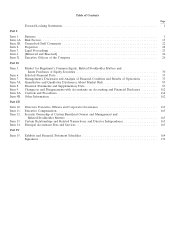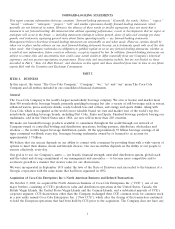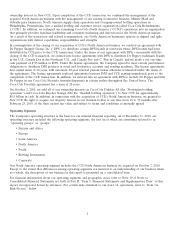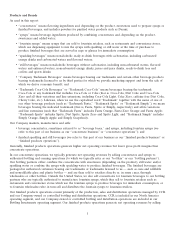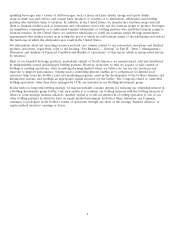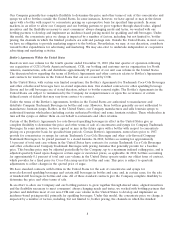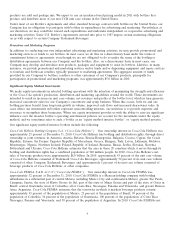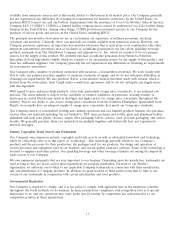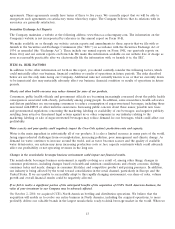Coca Cola 2010 Annual Report Download - page 6
Download and view the complete annual report
Please find page 6 of the 2010 Coca Cola annual report below. You can navigate through the pages in the report by either clicking on the pages listed below, or by using the keyword search tool below to find specific information within the annual report.sparkling beverages and a variety of still beverages, such as juices and juice drinks, energy and sports drinks,
ready-to-drink teas and coffees, and certain water products, to retailers or to distributors, wholesalers and bottling
partners who distribute them to retailers. In addition, in the United States, we manufacture fountain syrups and sell
them to fountain retailers such as restaurants and convenience stores who use the fountain syrups to produce beverages
for immediate consumption or to authorized fountain wholesalers or bottling partners who resell the fountain syrups to
fountain retailers. In the United States, we authorize wholesalers to resell our fountain syrups through nonexclusive
appointments that neither restrict us in setting the prices at which we sell fountain syrups to the wholesalers nor restrict
the territories in which the wholesalers may resell in the United States.
For information about net operating revenues and unit case volume related to our concentrate operations and finished
products operations, respectively, refer to the heading ‘‘Our Business — General’’ in Part II, ‘‘Item 7. Management’s
Discussion and Analysis of Financial Condition and Results of Operations’’ of this report, which is incorporated herein
by reference.
Most of our branded beverage products, particularly outside of North America, are manufactured, sold and distributed
by independently owned and managed bottling partners. However, from time to time we acquire or take control of
bottling or canning operations, often in underperforming markets where we believe we can use our resources and
expertise to improve performance. Owning such a controlling interest enables us to compensate for limited local
resources; help focus the bottler’s sales and marketing programs; assist in the development of the bottler’s business and
information systems; and establish an appropriate capital structure for the bottler. The Company-owned or controlled
bottling operations, other than those managed by CCR, are included in our Bottling Investments group.
In line with our long-term bottling strategy, we may periodically consider options for reducing our ownership interest in
a Bottling Investments group bottler. One such option is to combine our bottling interests with the bottling interests of
others to form strategic business alliances. Another option is to sell our interest in a bottling operation to one of our
other bottling partners in which we have an equity method investment. In both of these situations, our Company
continues to participate in the bottler’s results of operations through our share of the strategic business alliances’ or
equity method investees’ earnings or losses.
4


